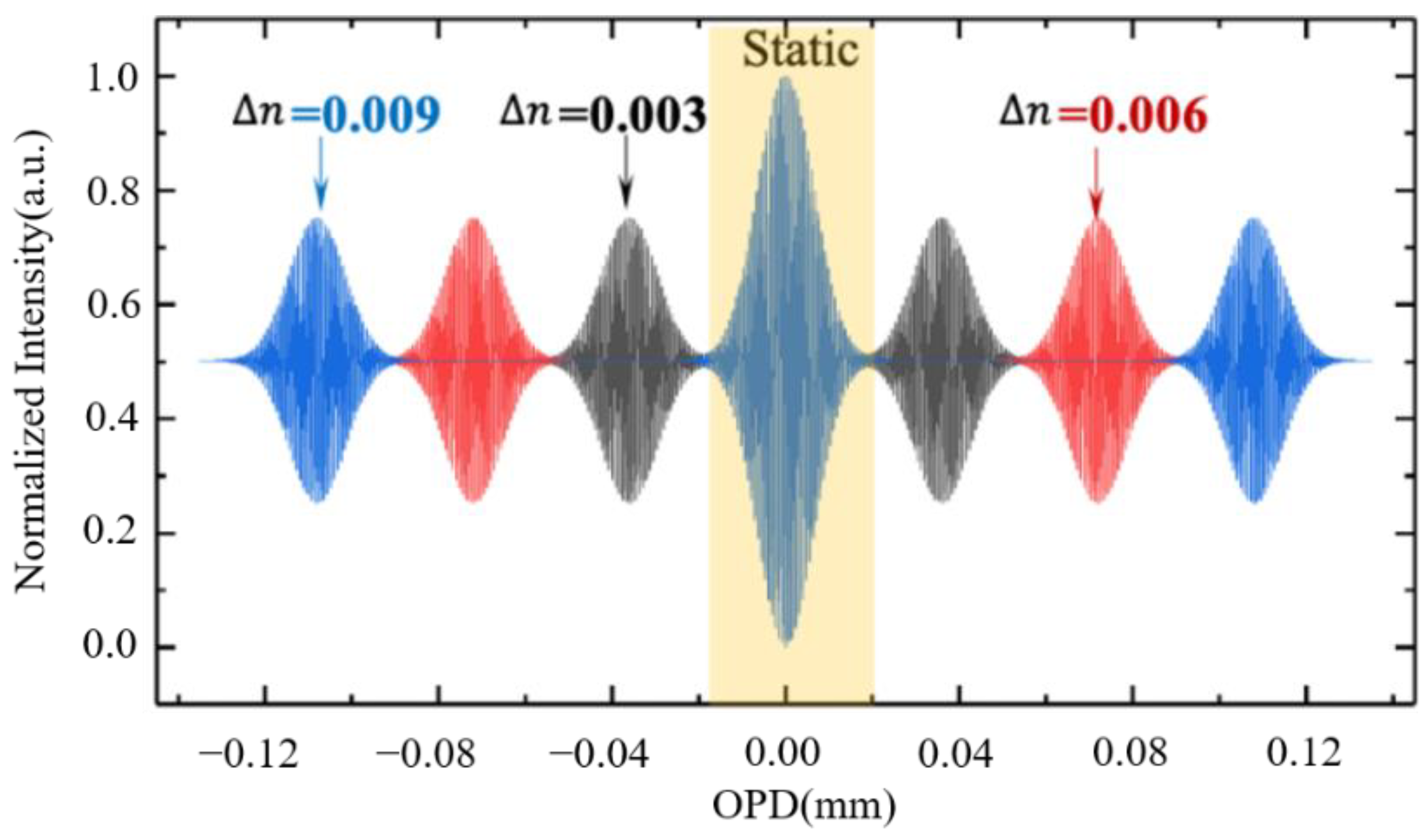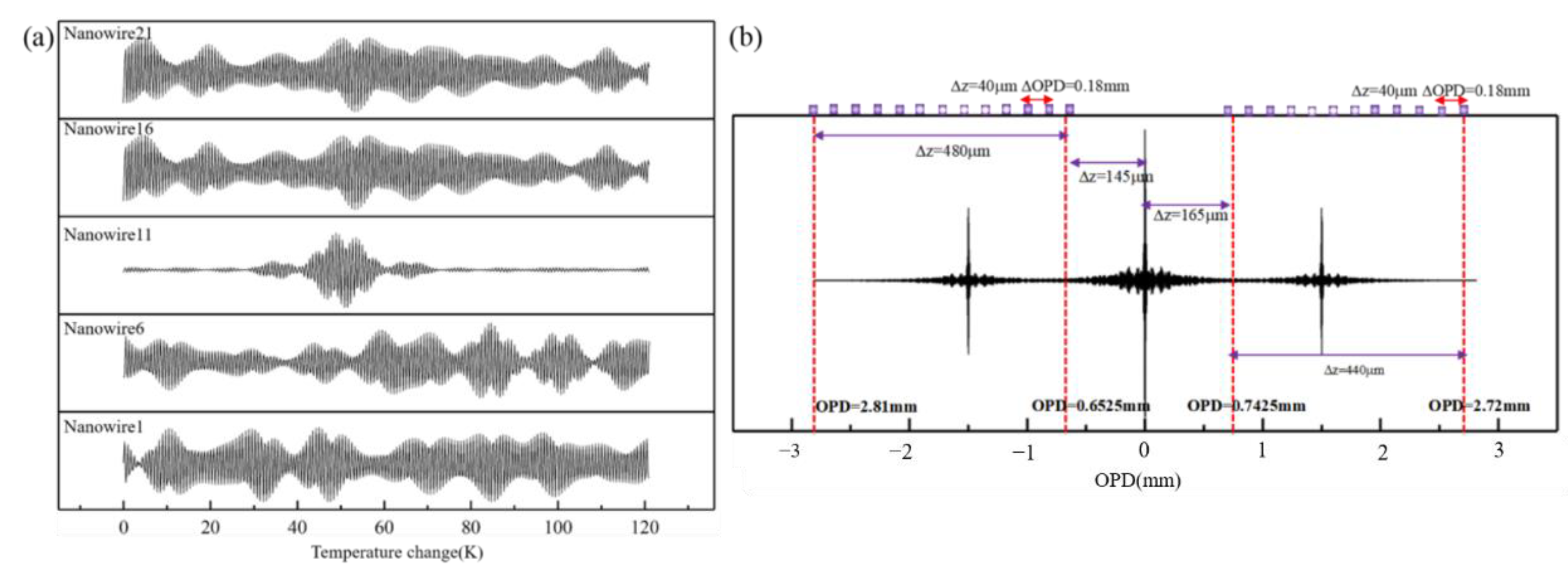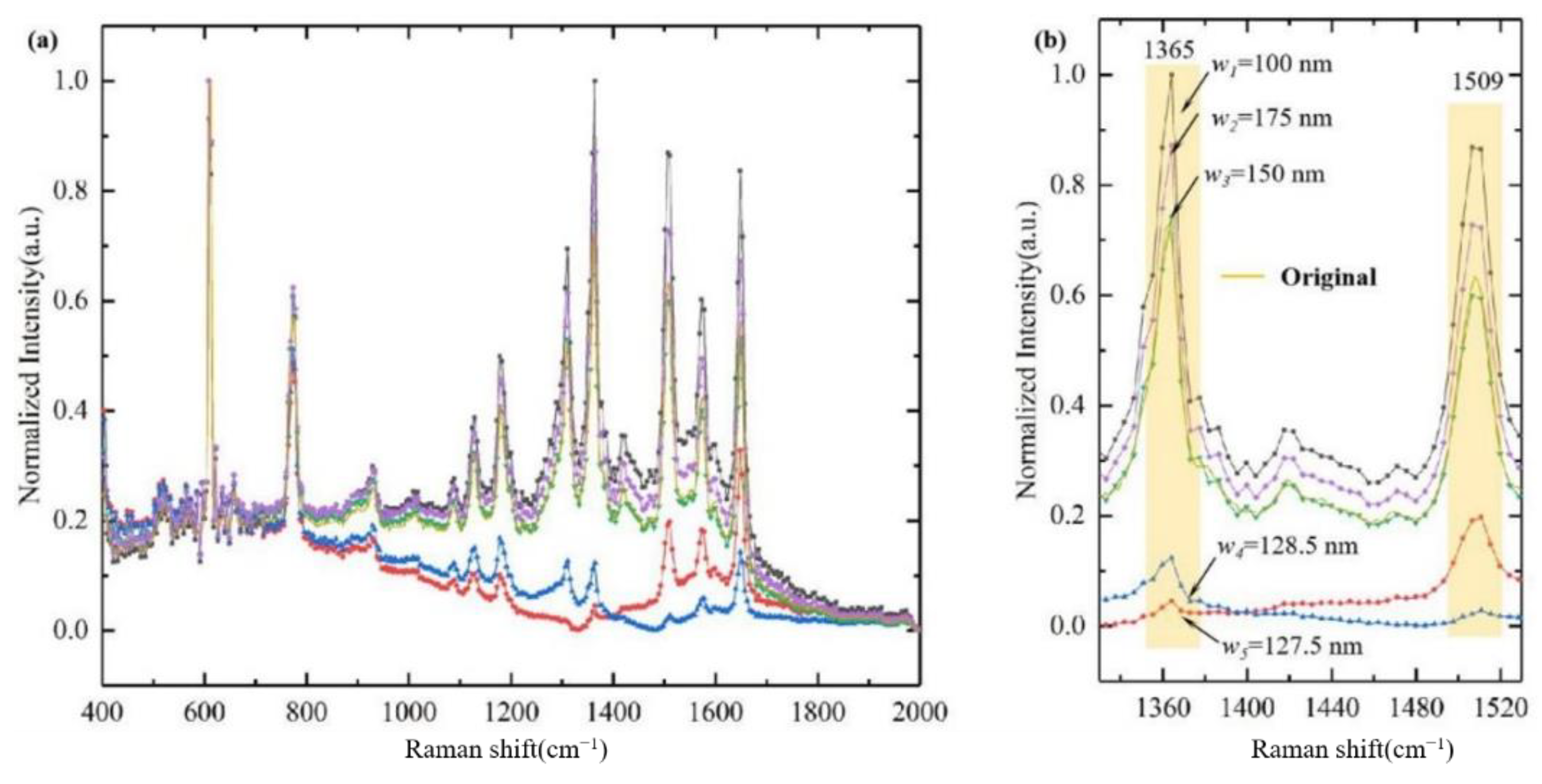Dual Tunable MZIs Stationary-Wave Integrated Fourier Transform Spectrum Detection
Abstract
1. Introduction
2. Theoretical Analysis of DTM-SWIFT
2.1. Spectral Detection System
2.2. Theoretical Analysis
3. Results
3.1. Gauss Spectrum as an Input
3.2. The Nanowire Width Effect
3.3. Raman Spectroscopy Detection
4. Conclusions
Author Contributions
Funding
Institutional Review Board Statement
Informed Consent Statement
Data Availability Statement
Acknowledgments
Conflicts of Interest
References
- Gajos, K.; Angelopoulou, M.; Petrou, P.; Awsiuk, K.; Kakabakos, S.; Haasnoot, W.; Bernasik, A.; Rysz, J.; Marzec, M.M.; Misiakos, K.; et al. Imaging and chemical surface analysis of biomolecular functionalization of monolithically integrated on silicon Mach-Zehnder interferometric immunosensors. Appl. Surf. Sci. 2016, 385, 529–542. [Google Scholar] [CrossRef]
- Nascetti, A.; Mirasoli, M.; Marchegiani, E.; Zangheri, M.; Costantini, F.; Porchetta, A.; Iannascoli, L.; Lovecchio, N.; Caputo, D.; de Cesare, G.; et al. Integrated chemiluminescence-based lab-on-chip for detection of life markers in extraterrestrial environments. Biosens. Bioelectron. 2019, 123, 195–203. [Google Scholar] [CrossRef] [PubMed]
- Tsopela, A.; Laborde, A.; Salvagnac, L.; Ventalon, V.; Bedel-Pereira, E.; Seguy, I.; Temple-Boyer, P.; Juneau, P.; Izquierdo, R.; Launay, J. Development of a lab-on-chip electrochemical biosensor for water quality analysis based on microalgal photosynthesis. Biosens. Bioelectron. 2016, 79, 568–573. [Google Scholar] [CrossRef] [PubMed]
- De Coster, D.; Loterie, D.; Ottevaere, H.; Vervaeke, M.; Van Erps, J.; Missinne, J.; Thienpont, H. Free-Form optics enhanced confocal raman spectroscopy for optofluidic Lab-on-Chips. IEEE J. Sel. Top. Quantum Electron. 2015, 21, 2701108. [Google Scholar] [CrossRef]
- Stojanovic, V.; Ram, R.J.; Popovic, M.; Lin, S.; Moazeni, S.; Wade, M.; Sun, C.; Alloatti, L.; Atabaki, A.; Pavanello, F.; et al. Monolithic silicon-photonic platforms in state-of-the-art CMOS SOI processes. Opt. Express 2018, 26, 13106–13121. [Google Scholar] [CrossRef] [PubMed]
- Shi, Y.; Xiong, S.; Zhang, Y.; Chin, L.K.; Chen, Y.; Zhang, J.; Zhang, T.; Ser, W.; Larson, A.; Hoi, L.S.; et al. Sulpting nanoparticle dynamics for single-bacteria-level screening and direct binding-efficiency measurement. Nat. Commun. 2018, 9, 815. [Google Scholar] [CrossRef] [PubMed]
- Mizaikoff, B. Waveguide-enhanced mid-infrared chem/bio sensors. Chem. Soc. Rev. 2013, 42, 8683–8699. [Google Scholar] [CrossRef]
- Podmore, H.; Scott, A.; Cheben, P.; Velasco, A.V.; Schmid, J.H.; Vachon, M.; Lee, R. Demonstration of a compressive-sensing Fourier-transform on-chip spectrometer. Opt. Lett. 2017, 42, 1440–1443. [Google Scholar] [CrossRef]
- Erfan, M.; Sabry, Y.M.; Sakr, M.; Mortdata, B.; Medhat, M.; Khalil, D. On-chip micro-electro-mechanical system Fourier transform infrared (MEMS FT-IR) spectrometer-based gas sensing. Appl. Spectrosc. 2016, 70, 897–904. [Google Scholar] [CrossRef] [PubMed]
- Ryckeboer, E.; Gassenq, A.; Muneeb, M.; Hattasan, N.; Pathak, S.; Cerutti, L.; Rodriguez, J.B.; Tournie, E.; Bogaerts, W.; Baets, R.; et al. Silicon-on-insulator spectrometers with integrated GaInAsSb photodiodes for wide-band spectroscopy from 1510 to 2300 nm. Opt. Express 2013, 21, 6101–6108. [Google Scholar] [CrossRef]
- Okayama, H.; Onawa, Y.; Shimura, D.; Takahashi, H.; Yaegashi, H.; Sasaki, H. Low loss 100 GHz spacing Si arrayed-waveguide grating using minimal terrace at slab-array interface. Electron. Lett. 2016, 52, 1545–1546. [Google Scholar] [CrossRef]
- Park, J.; Joo, J.; Kim, G.; Yoo, E.W.; Kim, S. Low-Crosstalk silicon nitride arrayed waveguide grating for the 800-nm band. IEEE Photonics Technol. Lett. 2019, 31, 1183–1186. [Google Scholar] [CrossRef]
- Malik, A.; Muneeb, M.; Shimura, Y.; Van Campenhout, J.; Loo, R.; Roelkens, G. Germanium-on-silicon planar concave grating wavelength (de)multiplexers in the mid-infrared. Appl. Phys. Lett. 2013, 103, 161119. [Google Scholar] [CrossRef]
- Zhu, N.; Mei, T. Focusing and demultiplexing of an in-plane hybrid plasmonic mode based on the planar concave grating. Opt. Commun. 2013, 298, 120–124. [Google Scholar] [CrossRef]
- Brouckaert, J.; Bogaerts, W.; Dumon, P.; Van Thourhout, D.; Baets, R. Planar concave grating demultiplexer fabricated on a nanophotonic silicon-on-insulator platform. J. Lightwave Technol. 2007, 25, 1269–1275. [Google Scholar] [CrossRef]
- Bogaerts, W.; Selvaraja, S.K.; Dumon, P.; Brouckaert, J.; De Vos, K.; Van Thourhout, D.; Baets, R. Silicon-on-Insulator spectral filters fabricated with CMOS technology. IEEE J. Sel. Top. Quantum Electron. 2010, 16, 33–44. [Google Scholar] [CrossRef]
- Momeni, B.; Hosseini, E.S.; Adibi, A. Planar photonic crystal microspectrometers in silicon-nitride for the visible range. Opt. Express 2009, 17, 17060–17069. [Google Scholar] [CrossRef]
- Momeni, B.; Hosseini, E.S.; Askari, M.; Soltani, M.; Adibi, A. Integrated photonic crystal spectrometers for sensing applications. Opt. Commun. 2009, 282, 3168–3171. [Google Scholar] [CrossRef]
- Redding, B.; Liew, S.F.; Sarma, R.; Cao, H. Compact spectrometer based on a disordered photonic chip. Nat. Photonics 2013, 7, 746–751. [Google Scholar] [CrossRef]
- Tsur, Y.; Arie, A. On-chip plasmonic spectrometer. Opt. Lett. 2016, 41, 3523–3526. [Google Scholar] [CrossRef]
- Liu, N.; Mukherjee, S.; Bao, K.; Li, Y.; Brown, L.V.; Nordlander, P.; Halas, N.J. Manipulating magnetic plasmon propagation in metallic nanocluster networks. ACS Nano 2012, 6, 5481–5488. [Google Scholar] [CrossRef]
- Golmohammadi, S.; Khalilou, Y.; Ahmadivand, A. Plasmonics: A route to design an optical demultiplexer based on gold nanorings arrays to operate at near infrared region (NIR). Opt. Commun. 2014, 321, 56–60. [Google Scholar] [CrossRef]
- Okamoto, K.; Aoyagi, H.; Takada, K. Fabrication of Fourier-transform, integrated-optic spatial heterodyne spectrometer on silica-based planar waveguide. Opt. Lett. 2010, 35, 2103–2105. [Google Scholar] [CrossRef] [PubMed]
- Yu, K.; Lee, D.; Krishnamoorthy, U.; Park, N.; Solgaard, A. Micromachined Fourier transform spectrometer on silicon optical bench platform. Sens. Actuator A-Phys. 2006, 130, 523–530. [Google Scholar] [CrossRef]
- Le Coarer, E.; Blaize, S.; Benech, P.; Stefanon, I.; Morand, A.; Lerondel, G.; Leblond, G.; Kern, P.; Fedeli, J.M.; Royer, P. Wavelength-scale stationary-wave integrated Fourier-transform spectrometry. Nat. Photonics 2007, 1, 473–478. [Google Scholar] [CrossRef]
- Pohl, D.; Escale, M.R.; Madi, M.; Kaufmann, F.; Brotzer, P.; Sergeyev, A.; Guldimann, B.; Giaccari, P.; Alberti, E.; Meier, U.; et al. An integrated broadband spectrometer on thin-film lithium niobate. Nat. Photonics 2020, 14, 24–29. [Google Scholar] [CrossRef]
- Ferrand, J.; Custillon, G.; Kochtcheev, S.; Blaize, S.; Morand, A.; Leblond, G.; Benech, P.; Royer, P.; Kern, P.; Le Coarer, E. A SWIFTS operating in visible and near-infrared. Proc. SPIE 2008, 7010, 701046. [Google Scholar]
- Velasco, A.V.; Cheben, P.; Bock, P.J.; Delage, A.; Schmid, J.H.; Lapointe, J.; Janz, S.; Calvo, M.L.; Xu, D.; Florjanczyk, M.; et al. High-resolution Fourier-transform spectrometer chip with microphotonic silicon spiral waveguides. Opt. Lett. 2013, 38, 706–708. [Google Scholar] [CrossRef] [PubMed]
- Liu, Q.; Ramirez, J.M.; Vakarin, V.; Le Roux, X.; Alonso-Ramos, C.; Frigerio, J.; Ballabio, A.; Simola, E.T.; Bouville, D.; Vivien, L.; et al. Integrated broadband dual-polarization Ge-rich SiGe mid-infrared Fourier-transform spectrometer. Opt. Lett. 2018, 43, 5021–5024. [Google Scholar] [CrossRef] [PubMed]
- Montesinos-Ballester, M.; Liu, Q.; Vakarin, V.; Ramirez, J.M.; Alonso-Ramos, C.; Le Roux, X.; Frigerio, J.; Ballabio, A.; Talamas, E.; Vivien, L.; et al. On-chip Fourier-transform spectrometer based on spatial heterodyning tuned by thermo-optic effect. Sci. Rep. 2019, 9, 14633. [Google Scholar] [CrossRef] [PubMed]
- Loridat, J.; Heidmann, S.; Thomas, F.; Ulliac, G.; Courjal, N.; Morand, A.; Martin, G. All integrated lithium niobate standing wave Fourier transform electro-optic spectrometer. J. Lightwave Technol. 2018, 36, 4900–4907. [Google Scholar] [CrossRef]
- Thomas, F.; Heidmann, S.; Loridat, J.; De Mengin, M.; Morand, A.; Benech, P.; Bonneville, C.; Gonthiez, T.; Le Coarer, E.; Martin, G. Expanding sampling in a SWIFTS-Lippmann spectrometer using an electro-optic Mach-Zehnder modulator. Proc. SPIE 2015, 9516, 95160B. [Google Scholar]
- Zanatta, A.R.; Gallo, I.B. The thermo optic coefficient of amorphous SiN films in the near-infrared and visible regions and its experimental determination. Appl. Phys. Express 2013, 6, 042402. [Google Scholar] [CrossRef]
- Elshaari, A.W.; Zadeh, I.E.; Jons, K.D.; Zwiller, V. Thermo-optic characterization of silicon nitride resonators for cryogenic photonic circuits. IEEE Photonics J. 2016, 8, 2701009. [Google Scholar] [CrossRef]
- Thomas, F.; Heidmann, S.; De Mengin, M.; Courjal, N.; Ulliac, G.; Morand, A.; Benech, P.; Le Coarer, E.; Martin, G. First results in near and mid IR lithium niobate-based integrated optics interferometer based on SWIFTS-Lippmann concept. J. Lightwave Technol. 2014, 32, 4338–4344. [Google Scholar] [CrossRef]







Publisher’s Note: MDPI stays neutral with regard to jurisdictional claims in published maps and institutional affiliations. |
© 2021 by the authors. Licensee MDPI, Basel, Switzerland. This article is an open access article distributed under the terms and conditions of the Creative Commons Attribution (CC BY) license (http://creativecommons.org/licenses/by/4.0/).
Share and Cite
Chen, X.; Huang, P.; Wang, N.; Zhu, Y.; Zhang, J. Dual Tunable MZIs Stationary-Wave Integrated Fourier Transform Spectrum Detection. Sensors 2021, 21, 2352. https://doi.org/10.3390/s21072352
Chen X, Huang P, Wang N, Zhu Y, Zhang J. Dual Tunable MZIs Stationary-Wave Integrated Fourier Transform Spectrum Detection. Sensors. 2021; 21(7):2352. https://doi.org/10.3390/s21072352
Chicago/Turabian StyleChen, Xinyang, Peijian Huang, Ning Wang, Yong Zhu, and Jie Zhang. 2021. "Dual Tunable MZIs Stationary-Wave Integrated Fourier Transform Spectrum Detection" Sensors 21, no. 7: 2352. https://doi.org/10.3390/s21072352
APA StyleChen, X., Huang, P., Wang, N., Zhu, Y., & Zhang, J. (2021). Dual Tunable MZIs Stationary-Wave Integrated Fourier Transform Spectrum Detection. Sensors, 21(7), 2352. https://doi.org/10.3390/s21072352




